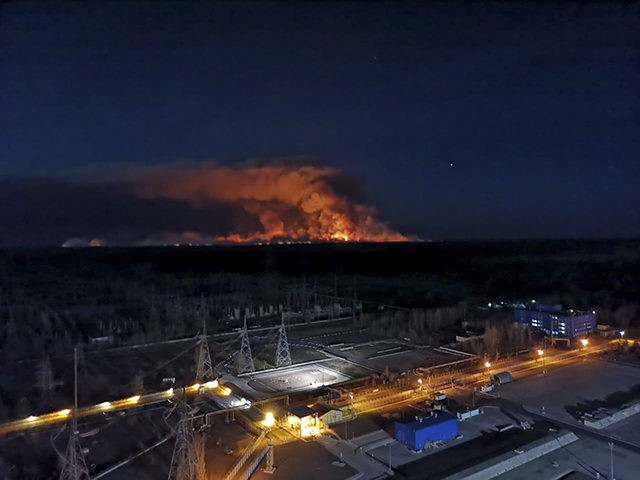Officials in Ukraine asserted on Tuesday that a sprawling fire threatening to engulf the site of the world’s worst nuclear disaster, the Chernobyl nuclear power plant, had finally come under control, but not before reaching Pripyat, the ghost town once built to house power plant workers.
“Aerial inspection of the last fires was made today (April 14) at 7 a.m. Today they will be completely extinguished,” Ukraine’s deputy interior minister, Anton Gerashchenko, asserted on Facebook, according to the Kyiv Post. Officials reportedly insisted that all that remained of the fire in the Chernobyl Exclusion Zone, a thousand-square-mile area the government has isolated as highly radioactive and dangerous to humans, were “embers” and bits of fire with no large pockets.
A separate Ukrainian government statement on Tuesday plainly asserted there is “no open fire” in the exclusion zone.
Ukrainian authorities said they had deployed 400 firefighters and other emergency personnel and nearly 100 aircraft, fire trucks, and other vehicles to the exclusion zone to target and isolate the fires sprawling over the dry, abandoned area. Gerashchenko reportedly stated that rain overnight from Monday to Tuesday helped to significantly curtail the fires.
The change in language from Ukrainian officials occurred rapidly; hours prior, they expressed concern that the weather was working against them. Emergency official Viktoria Ruban told reporters Tuesday that strong gusts of wind were helping spread the fire throughout a greater area, according to Radio Free Europe (RFE/RL). The outlet noted that some spokespeople for the government had said it was “impossible” to know when they would bring the fire under control.
“Nobody can give any forecast due to the simple reason that there were very strong winds yesterday that made the fire move at a very high speed,” RFE/RL quoted Ruban as saying. “Secondly, in the areas where the fire was practically eliminated last evening, new fire sites have appeared in places that are hard to access. The major problem is that new fire sites are emerging.”
Ruban confirmed that the fire had reached Pripyat, a town built in the 1980s for the workers of the Chernobyl Nuclear Power Plant. Pripyat was abandoned on April 26, 1986, shortly after the power plant melted down as a result of communist mismanagement. Its residents were told they were temporarily evacuating for their safety, but have never been allowed to return.
The fire reportedly reached an abandoned train station in Pripyat before being contained, according to Ruban.
Reports circulated, propelled by environmentalist groups like Greenpeace, of radiation levels rising and the power plant itself — encased in a concrete husk intended to keep the most dangerous radioactive waste contained — threatened by the fire. The BBC cited reports stating that the fire was a little over a mile away from the plant.
Authorities insisted, however, that there was no threat of the fire reaching the plant. “Please don’t spread fakes and panic,” Gerashchenko, the deputy interior minister, wrote on Facebook, according to the Kyiv Post.
Gerashchenko also claimed the radioactive waste at the plant was “completely safe.”
Statements from Ukrainian authorities did confirm the fire’s devastation of other abandoned villages in the vast exclusion zone. The Ukrainian news agency UNIAN reported on Tuesday that at least 12 of these villages had burned down entirely, along with “old cemeteries, forests, and swamps.” There are no reports yet of any person injured or killed by the fires, despite the fact that some older people never evacuated the “abandoned” villages in the area. Police have largely let older people live in peace in the area despite mandating that most evacuate in the 1980s, as the psychological trauma of losing their homes, some contended, may have been greater than the physical damage to seniors.
Multiple Ukrainian officials have also stated that, despite the fire spreading fumes throughout the exclusion zone, radiation levels there remain at “permissible” levels.
Ukrainian President Volodymyr Zelensky weighed in on the fires on Monday, insisting that investigations into how the fire began continue and “the public must know the truth.” At press time, Kyiv has identified a 27-year-old man as the prime suspect. The individual reportedly admitted to setting garbage on fire in the exclusion zone “for fun,” but did not claim he intended to burn down any significant acreage of the exclusion zone. The man faces a maximum of five years in prison, a sentence some have criticized as too small compared to the damage potentially caused by such a fire.
“I’m closely monitoring the situation in the Chernobyl zone. I know firefighters are doing their best. I am thankful for their courage,” Zelensky said in a statement posted on Facebook on Monday. “I’ll hear a report on the fires from Chairman of the State Emergency Service of Ukraine Mykola Chechotkin tomorrow [April 14]. Conclusions will follow soon after. The public must know the truth and be safe.”
Authorities first identified fires on April 4. While no one, save for the few elders remaining, is allowed to live in the exclusion zone, Ukraine has expanded the tourism industry there and allows monitored, short-term tours of Pripyat and the plant itself.
Ukraine will observe the 34th anniversary of the Chernobyl nuclear disaster on April 26.

COMMENTS
Please let us know if you're having issues with commenting.